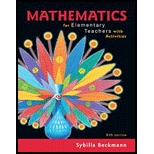
Concept explainers
Using an Internet browser, go to one of the following websites and find a graph or data display that interests you:
. census.gov, the website of the U.S. Census Bureau, click on “Data” and then on “Visualizations”;
. nationsreportcard.gov, the website of the National Assessment of Educational Progress (NAEP), and look under “Dashboards” or “Reports”;
. cdc.gov, the website of the Centers for Disease Control and Prevention (CDC), and click on “Data & Statistics”;
. pewresearch.org, the website of the Pew Research Center, and click on “Data”;
. theharŕspoll.org, the website of the Harris Poll;
. YouGov.com, the website of YouGov.
Describe or include a picture of the data display and provide alink to it. Write at least four questions about the data display,including at least one question at each of the three graphreading levels discussed in this section. Label each questionwith the level you think fits best. Answer each of your questionsto the extent possible and explain your answers. Now repeat theentire process with a different data display.
Want to see the full answer?
Check out a sample textbook solution
Chapter 15 Solutions
Mathematics for Elementary Teachers with Activities (5th Edition)
Additional Math Textbook Solutions
College Algebra (Collegiate Math)
Pathways To Math Literacy (looseleaf)
Introductory Statistics
Finite Mathematics for Business, Economics, Life Sciences and Social Sciences
A First Course in Probability (10th Edition)
- No chatgpt pls will upvotearrow_forwardnot use ai pleasearrow_forward4 In the integral dxf1dy (7)², make the change of variables x = ½(r− s), y = ½(r + s), and evaluate the integral. Hint: Find the limits on r and s by sketching the area of integration in the (x, y) plane along with the r and s axes, and then show that the same area can be covered by s from 0 to r and r from 0 to 1.arrow_forward
- 7. What are all values of 0, for 0≤0<2л, where 2 sin² 0=-sin? - 5π 6 π (A) 0, л, and 6 7π (B) 0,л, 11π , and 6 6 π 3π π (C) 5π 2 2 3 , and π 3π 2π (D) 2' 2'3 , and 3 4元 3 1 די } I -2m 3 1 -3 บ 1 # 1 I 3# 3m 8. The graph of g is shown above. Which of the following is an expression for g(x)? (A) 1+ tan(x) (B) 1-tan (x) (C) 1-tan (2x) (D) 1-tan + X - 9. The function j is given by j(x)=2(sin x)(cos x)-cos x. Solve j(x) = 0 for values of x in the interval Quiz A: Topic 3.10 Trigonometric Equations and Inequalities Created by Bryan Passwaterarrow_forwardnot use ai pleasearrow_forward-xx0. B2 If Xfx(x) find the MGF in the case that fx(x) = - 1 28 exp{-|x − a\/ẞ}, Use the MGF to compute E(X) and Var(X).arrow_forward
- Name Assume there is the following simplified grade book: Homework Labs | Final Exam | Project Avery 95 98 90 100 Blake 90 96 Carlos 83 79 Dax 55 30 228 92 95 79 90 65 60 Assume that the weights used to compute the final grades are homework 0.3, labs 0.2, the final 0.35, and the project 0.15. | Write an explicit formula to compute Avery's final grade using a single inner product. Write an explicit formula to compute everyone's final grade simultane- ously using a single matrix-vector product.arrow_forward1. Explicitly compute by hand (with work shown) the following Frobenius inner products 00 4.56 3.12 (a) ((º º º). (156 (b) 10.9 -1 0 2)), Fro 5')) Froarrow_forward3. Let 4 0 0 00 0 0 1.2 0 00 0 0 0 -10.1 0 0 0 D = 0 0 0 00 0 0 0 0 05 0 0 0 0 0 0 2.8 Either explicitly compute D-¹ or explain why it doesn't exist.arrow_forward
 Glencoe Algebra 1, Student Edition, 9780079039897...AlgebraISBN:9780079039897Author:CarterPublisher:McGraw Hill
Glencoe Algebra 1, Student Edition, 9780079039897...AlgebraISBN:9780079039897Author:CarterPublisher:McGraw Hill Holt Mcdougal Larson Pre-algebra: Student Edition...AlgebraISBN:9780547587776Author:HOLT MCDOUGALPublisher:HOLT MCDOUGAL
Holt Mcdougal Larson Pre-algebra: Student Edition...AlgebraISBN:9780547587776Author:HOLT MCDOUGALPublisher:HOLT MCDOUGAL Big Ideas Math A Bridge To Success Algebra 1: Stu...AlgebraISBN:9781680331141Author:HOUGHTON MIFFLIN HARCOURTPublisher:Houghton Mifflin Harcourt
Big Ideas Math A Bridge To Success Algebra 1: Stu...AlgebraISBN:9781680331141Author:HOUGHTON MIFFLIN HARCOURTPublisher:Houghton Mifflin Harcourt


